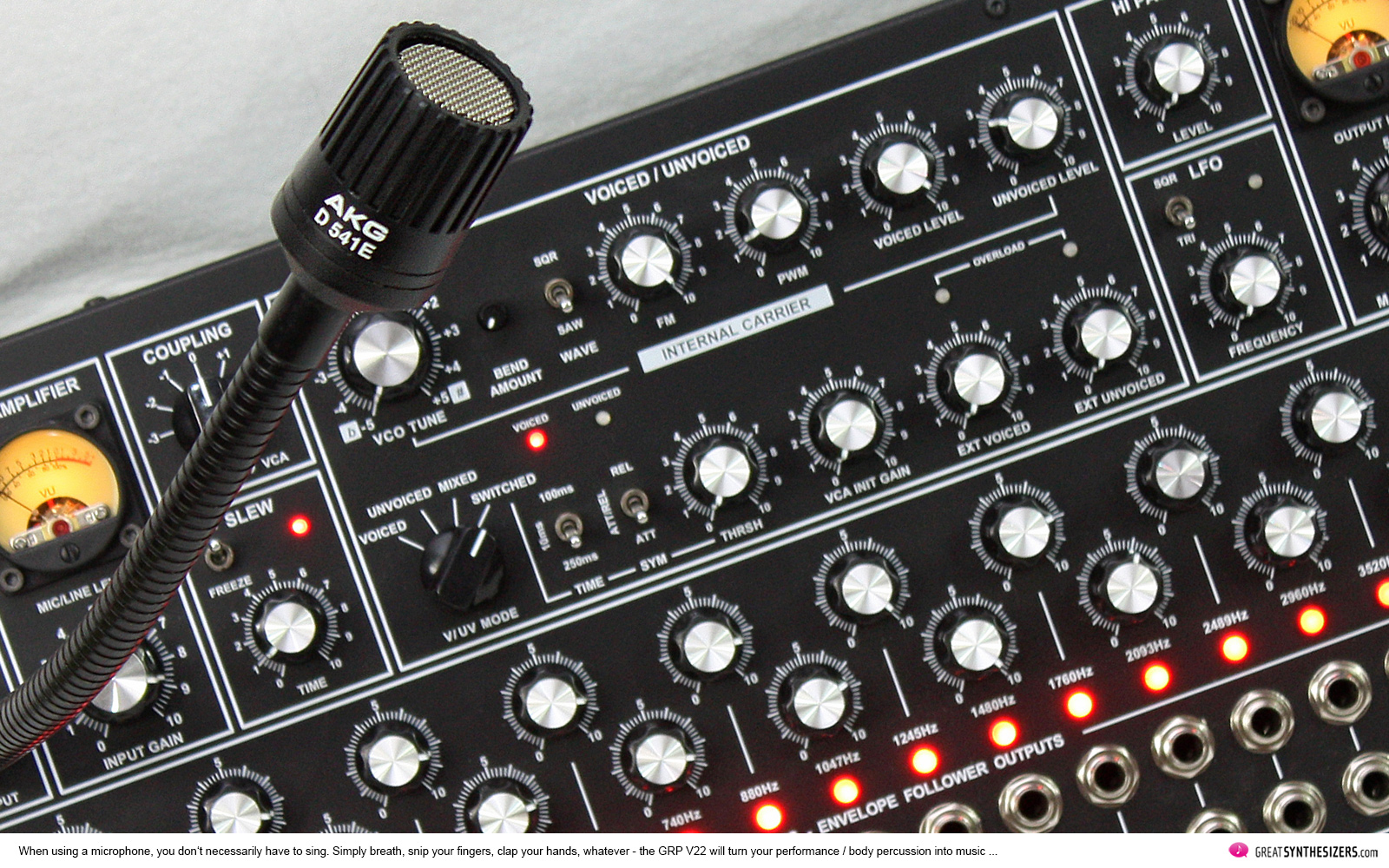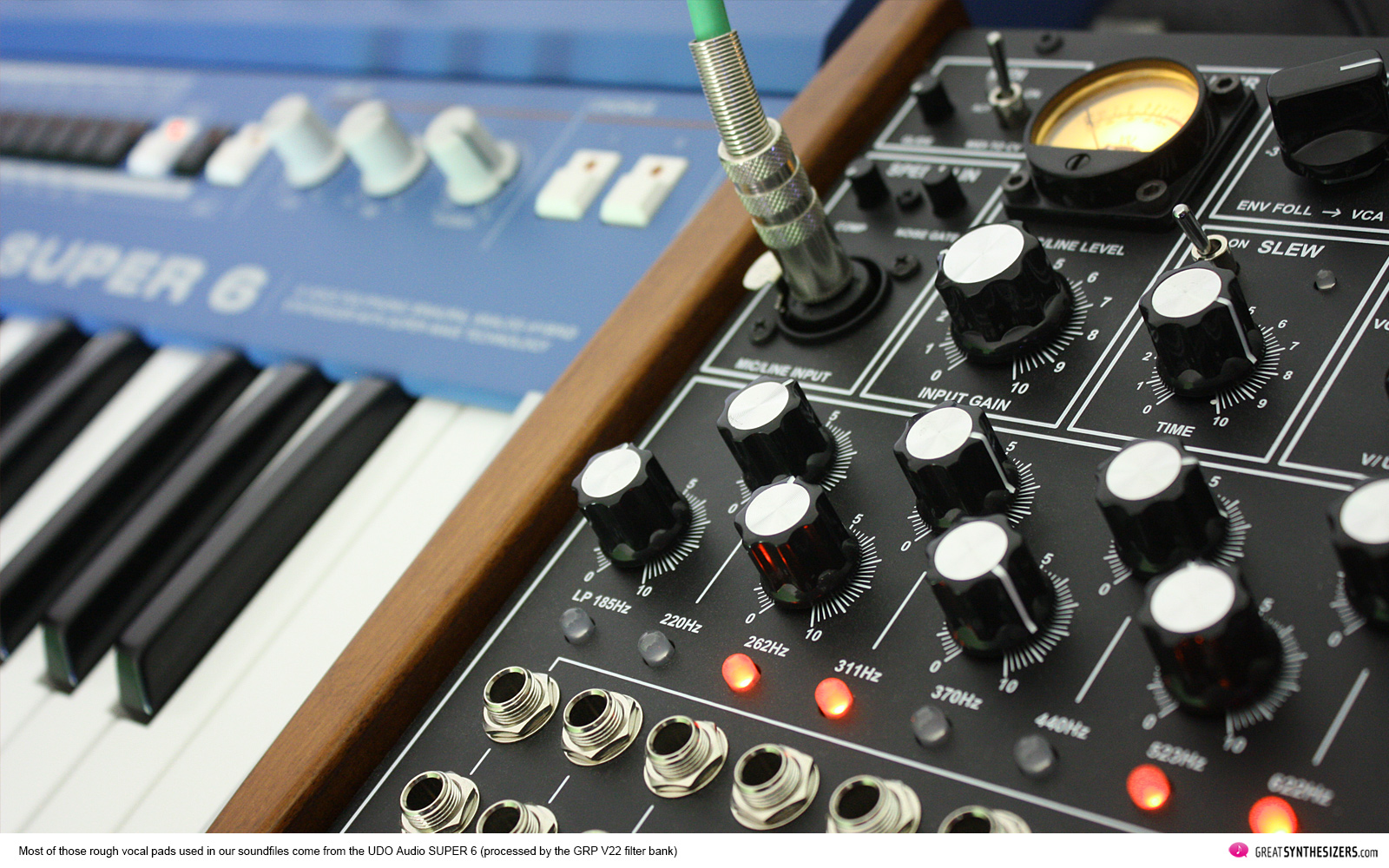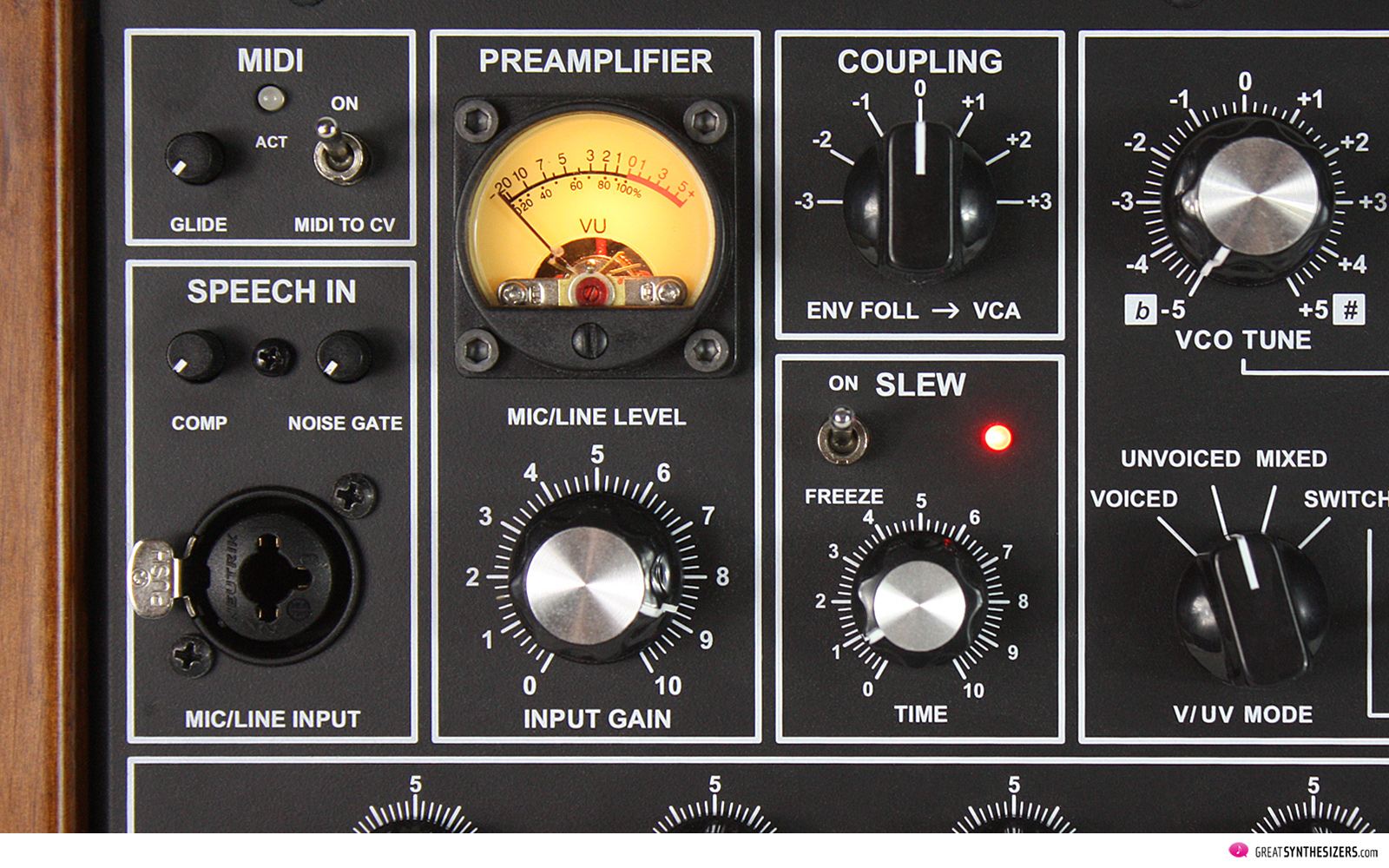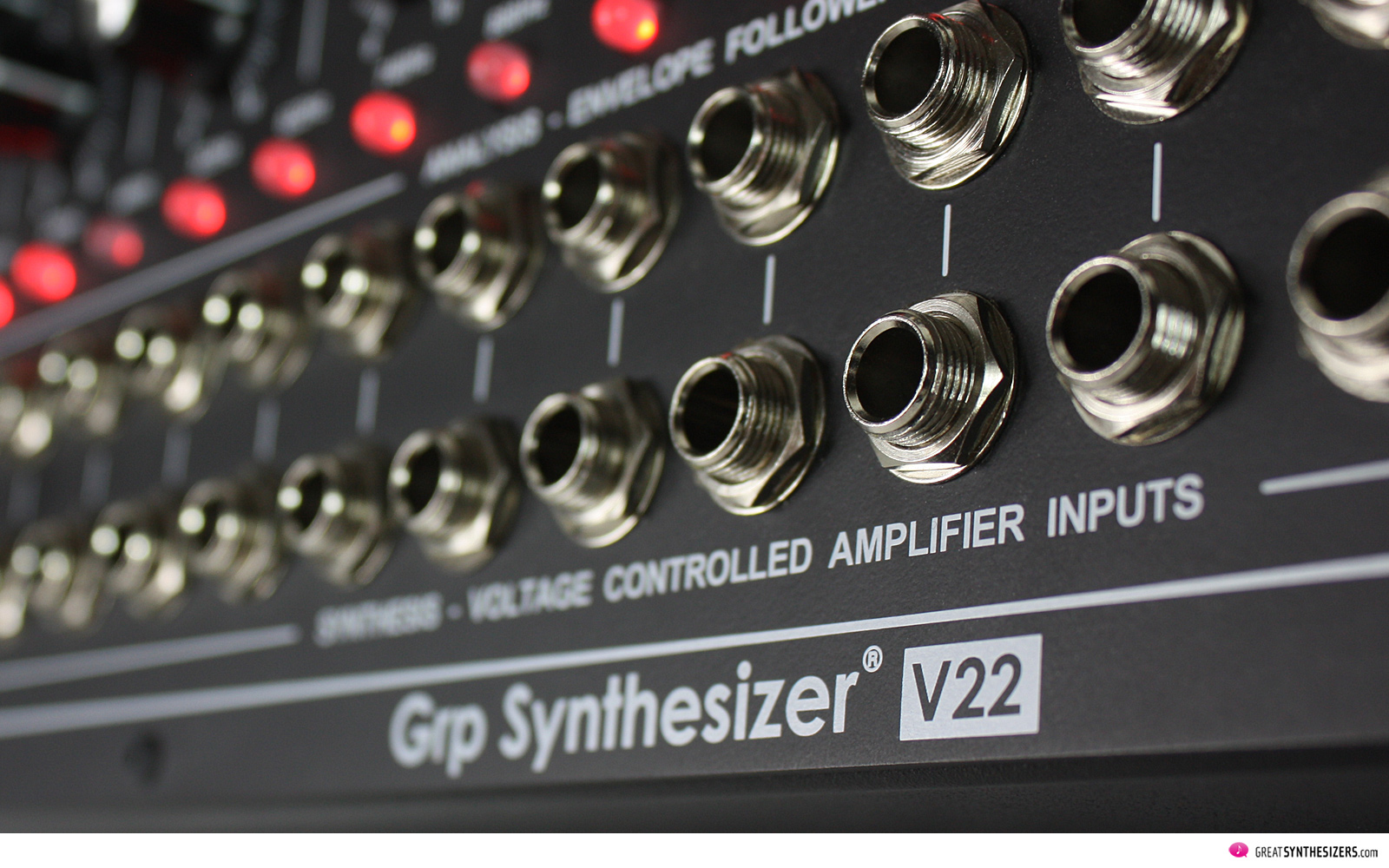First, a confession. Our test report on the GRP V22 Vocoder is overdue by 9 months. Outrageous! To be perfectly clear: This is not a reflection on the quality of the instrument. We just needed time. We were struggling with the very basics of how a professional vocoder works.
In the meantime, the GRP V22 has turned our studio upside down, ushered in a Copernican turnaround, and launched a new approach to music electronics. Now we wouldn’t want to be without the GRP V22 and its Voices from Outer Space.
Why did it take so long? A partial answer: Years of working with synths have tended to limit our musical horizon to oscillators, filters, amplifiers, envelopes and the use of a keyboard. Something NEW arriving on the table – take the GRP V22 vocoder as an example – left your reviewer, poor sucker, surrounded by tons of question marks.
A quick glance at the history of the Vocoder
The irony of the story: The NEW is by no means new. On the contrary – the vocoder is one of the oldest devices in the field of electronic signal transmission. Keyword interwar years, keyword Bell Laboratories. Important personalities had to be able to exchange important messages in an encrypted way. The VOice enCODER – that mysterious voice coding device – was launched. USA, 1936, a long time ago.
The vocoder found its way into experimental music electronics in the 1960s and into commercial music electronics in the 1970s. And the vocoder, sometimes equipped with a keyboard, began its triumphant march into electronic pop music. Vocal robots … Kraftwerk with its famous song “The Robots” … such musical successes are well known.
While vocoders with direct access to all filters / bands / frequency ranges (EMS, Sennheiser, Moog …) usually belonged to the particularly exquisite effects devices in the studio (as they still do so today), the generally cheaper vocoders with keyboard (Roland, Korg, …) usually offered no – at the best limited – access to the individual frequency ranges.
In return, those instruments equipped with a keyboard – such as the legendary Roland VP-330 or the equally well-known Korg VC-10 – were extremely user-friendly, providing immediate electronic choirs, robot- or effect-voices to the musician who was singing (possibly speaking) into a microphone.
So far so good. A little more patience, please, because this historical outline relates directly to the GRP V22. The “Voice from Outer Space” (as we call the test candidate) is a product of the first category, a professional desktop / rack-mount instrument without its own keyboard (but with MIDI), with 22 freely accessible filter areas.
Quality hardware has its price
The difference lies in those 22 filters / frequency ranges / bands, which not only extend musical possibilities, but are also a huge cost factor (with all vocoders)! If each filter(pair) is equipped with its own envelope follower and its own VCA, that’s expensive! No wonder the earlier EMS 5000 vocoder cost a fortune. No wonder a Moog vocoder – with 16 filters / bands – seemed unaffordable. The new edition still sells for a proud 6,000 Euros. Seen that way, the 4,700 Euros for a GRP V22 almost seems cheap. And it comes with a superb 22 filters / bands.
No doubt about it, quality hardware has its price! This is nothing to gloss over here, but we can put it into perspective: The scope of performance potential a pro-vocoder provides is mind-boggling. Robo voices and electronic choirs, yep – the clichés are part of what you get. But in addition you get a vast field for experimentation – be it for all forms of body percussion, be it for all types of acoustic performance transformable into new soundscapes (via a microphone / line signal and selected frequency ranges). Not to forget that a pro-vocoder is also a brillant fixed filter bank (22 filters, in this case) for all the finesse of elegant manipulation of synthesizer sounds, drum sounds, etc.
GRP V22 – the features
As you know, a vocoder essentially consists of two parts – the analysis part and the synthesis part. In essence, however, the functionality of the vocoder is very complex. The different components of an audio signal – a voice, for instance (consisting of vowels, voiced consonants (“Voiced”), unvoiced consonants alias silibants (“Unvoiced”)) – must be analyzed and reproduced / synthesized as closely as possible using a carrier signal and lots of frequency bands. The whole procedure requires technical sophistication and many a trick. Remember that poor sucker, heh?
At this point we do not want to bother with long explarnations (which do not come from us in any way), nor adorn ourselves with foreign feathers. The Book “Synthesizer” by Florian Anwander is recommended as an excellent source, providing helpful explanations of the complex technology. Unfortunately, it’s only in German. In the chapter “Vocoder” (page 129 ff) the function and structure of the device are defined clearly, including explanations for the use of the Doepfer A-100 vocoder modules A-129/1 (Vocoder Analysis Section) and A-129/2 (Vocoder Synthesis Section). Another valuable source of information is this Vocoder article (Wikipedia).
With regard to the GRP V22, we will content ourselves with a list of its most important features, along with a few notes particularly relevant from a musical point of view …
The GRP V22 offers:
- A combined microphone / line input (for the modulator signal)
- Compressor and Noise Gate, depending on the application
can lead to a more constant modulator signal - MIDI-IN to control the internal VCO (carrier signal),
alternatively manual control or via CV input - 22 * bands / frequency ranges / fixed filters (LowPass, 20x BandPass, HighPass)
- Manual volume control and LED display per frequency range / filter
- Envelope Follower CV output and VCA CV input per frequency range / filter
- Freeze, with which the microphone-signal (line-signal) temporarely “freezes” and can then be optimized step by step – well, frequency by frequency – using the filter bank
- A Slew function with which the – well – slew rate of the envelope followers can be adjusted … it’s sort of a global attack time of the Vocoder sound
- A Coupling function that shifts the frequency bands between analysis and synthesis
crosswise up or down – for even more possibilities of audio experiments
[ * Since the analysis part and the synthesis part each has its own filter bank, we believe there are in fact 44 filters built into the GRP V22! ]
- An internal VCO as a carrier signal, with sawtooth and pulse wave
(Voiced signal) and Noise (Unvoiced signal) - An LFO (0.02 Hz – 13 Hz, with triangle and square) for FM and PWM of the VCO
- MIDI pitchbend function of the VCO (+/- 12 semitone)
- A separate HPF to improve / brighten the outgoing vocoder signal
- Audio inputs for external voiced / unvoiced signals, in addition to the
(or instead of the) internal VCO (carrier) - Left output, right / mono output and a separate VCO output (carrier)
- An interesting concept of audio panorama:
Left / Right mode with a spatial stereo sound - The upper row of the BandPass filters appears on the
left channel, the bottom row on the right channel - LowPass filter (1st VCF) and HighPass filter (22nd VCF) are
automatically routed to both the right and left output - MIDI IN / MIDI THRU / USB (MIDI IN)
x
The V22 comes with wooden side panels and rack rails. Please note: Unlike the GRP A2 / GRP R24, the 4 screws on the wooden side parts do not (!) fit the rack rails of the GRP V22. Instead, there are 4 extra (shorter) screws included for rack mounting.
GRP V22 – in practice
Leaving the complex technicalities aside, we come to the practical part. And that’s a real baby. We were astonished to find out that with an open vocoder alias GRP V22 it is – surprise – not so easy to instantly achieve those typical vocoder-voice effects. It took a considerable amount of practice and some patient tweaking of the compressor, noise gate and separate high-pass filter to get a convincing “We are the robots” sound. On the winning side, our experimental route demonstrated many areas of vocoder application. These go far beyond simple voice effects …
GRP V22: The Synthesizer
– a ride through the audio frequencies
Since several GRP V22 modules can be found in a lot of analog synthesizers (VCO, LFO, VCF, VCA, …), let’s begin there. Take the internal VCO (Carrier). 22 filters bestow the vocodered VCO-sound with unique timbres. Now, if you are looking for the gate / triggering impulse or the envelopes, something traditional to “trigger” the sound – no chance. The music is activated via the microphone- / line-signal. After all, we are dealing with a VOCODER (… the envelope followers in the analysis part control the VCAs of the filters in the synthesis part). So, the microphone signal is the key to your success …
You don’t have to sing to make Vocoder music. Ordinary breathing into the microphone is enough to bring the VCO (Carrier) to life. And in contrast to the sharp trigger- / gate-impulses of a traditional synthesizer (via keyboard, CV/Gate, MIDI, USB), the musical phrases of an air-controlled Vocoder synthesizer have a distincitive flowing naturalness, mirroring your breathing. Incidentally, the generous GRP V22 VCO extends into sub-audio / LFO range, which makes the creation of experimental soundscapes (breath-controlled LFO, for example) even easier. Tweak the VCO TUNE button from audio to sub-audio and back and make the results audible by breathing. A new experience for any keyboard player!
However, this is only the outer layer of the surprise package we’re getting into. It is no coincidence that the two VCO waveforms are sawtooth and pulse. Both have a high overtone content and allow a huge variety of frequencies to be filtered out. If you select sawtooth, for example, convincing vowel sounds can be generated by lowering or increasing individual frequency bands. The results are reminiscent of a Didgeridoo (remember the Australien wind instrument?) or of Mongolian overtone singing. Mystical, unearthly. If the individual GRP filters are now themselves modulated by external control voltages (LFOs, sequencers, envelopes, whatever), then we are left speechless. Textures and voices from outer space …
GRP V22: The Performance Tool
– a cv-controllable fixed filter bank
The aforementioned example leads us in a new direction. The individual (voltage controllable) filters can process any audio signal. If we replace the internal VCO with an external synthesizer – in our sound files this was the UDO Audio SUPER 6 (as Carrier) – this opens up new sonic vistas. Polyphonic Mongolian overtone singing? No problem! All is controlled by a microphone signal, by breathing. Just snapping your fingers is also very effective. Clapping – wonderful! Or rubbing your hands! This all may seem a little strange, if not to say ridiculous, but the musical results are baffling.
The fixed filter bank (22 parallel band pass filters) is a true goldmine for audio processing. Try replacing the microphone with the UDO Audio SUPER 6 signal (this time used as Modulator) and processing its sounds directly. Every single SUPER 6 patch can be transformed into something completely different. 22 fixed filters = 22 frequency ranges. No stone is left in place. Boost individual frequency bands only – very effective. Sounds begin to live, to move organically. Remember the possibility of voltage controlling all 22 bands? That’s raising sound design to a new level! But even when manually tweaking the filters, there are a myriad of possibilities. Highlighting and lowering certain frequency ranges gives the sound that extra acoustic flavor. The whole procedure of using such an elaborate filter bank is not only effective, but at the same time very simple.
GRP V22: The Vocoder
– an open field for experimentation
We deliberately put the vocoder in third place. The obvious isn’t the spectacular in the GRP V22. Actually, anyone can do vocoding. There are cheap and yet good hardware vocoders out there (such as Korg microKORG, Novation MiniNova, Roland Jupiter-X/Xm, Waldorf STVC). There are great Eurorack vocoders out there (such as the AnalogFX VXC-2220 based on the Synton 222). And there are very useful software vocoders out there (Arturia Vocoder V, XILS Lab XILS V+, freeware Full Bucket Vocoder FBVC and others). If it was only about the typical Kraftwerk “We are the robots” effect, the GRP V22 would be clearly oversized. But it’s about more, it’s about hardware quality and it’s about those extra extras. The 22 bands alone are a quality feature.
One special thing about the V22 vocoder aside from its comprehensive frequency bank is its package of infinite possibilities. Be it through the Coupling function, the creation of new structures through cross-frequency-shifts. Be it through the experimental use of the noise gate, where robot voices or nasal choirs can even been made to sound specifically “ugly”. Or be it through the completely free routing of the basic signals. Do you have to sing with the vocoder? Not at all. Can a drum computer be “the voice”, so to speak? And a signal fed in via a microphone be the carrier? Sure, there are no restrictions …
Background noises – those extra extras
A side effect from working with the GRP V22 (as with any hardware vocoder): Background noises are a boon. They are always there, to varying degrees – through the microphone, through the sum of the many filters (actually VCAs), through the reaction of the noise gate, whatever. Thus, a “human aspect” is austomatically lent to your vocoder sounds. This may lead to your more concious handling of audio signals. HiFi might turn into LoFi. And by lowering the HiFi standard, the mystical sounds in your music (partly realized by the GRP V22 and its background noises) will gain in authenticity.
Once you’ve got that far (at which time the acoustic sterility of music electronics will have been broken a bit), the generosity inherent in inaccuracy will begin to assert itself – on this, and on other levels as well. Inaccuracy is actually a real factor in rhythmic elements. Body percussion (your very special vocoder performance (o:) doesn’t follow the pulse of the MIDI clock anyway, so a slight delay in any parallel sequencer- or drum-machine-setup suddenly results in a more coherent overall acoustical picture. The music begins to live, partly thanks to those air-controlled GRP V22 performances. A nice side-effect, indeed.
[ Background noises resulting from overloading can of course arise during operation (… we speak from experience). For example when too many filters are turned up at the same time. But even that is usually only selective and does not have to interfere with the overall sound. If so, simply repeat the performance with appropriate adjustments. ]
Conclusion
The GRP V22 is like an unpolished jewel. It doesn’t look very spectacular, although its price is by no means a bargain. But … this unique instrument is sure to change the acoustic world in many studios. Its myriad of sophisticated musical possibilities (22 filterbands with manual access + CV control, real stereo sounds with alternating R / L frequency bands) and its open performance access make this vocoder a goldmine for those looking for experimental audio processing. The GRP V22 is a tantalizing source of new sounds.
Sounds that often have something inexplicably mystical about them, far removed from good old-fashioned electronic and synthesizer music. Such sounds can only be achieved by the likes of a (professional) vocoder such as the GRP V22 (or, again, the Moog Vocoder). Ultimately, the GRP V22 forms an experimental interface between synthesizers, drum computers and modular systems, casting tonal creativity in a new light and lending striking nuances to studio performance.
A significant amount of the acoustic results are achieved via breath control or via body percussion, a special distinction of the vocoder concept. The musician himself becomes a vital element in the performed sound, with background noises (intentional or unintentional) lending the music life and authenticity. This becomes immediately obvious when working with the GRP V22.
x
______________________________________________
The following 50 minutes of audio will give you a better insight into the V22 world. As may become evident, those stereotypical robo-voices (“… it’s a VOCODER!”) make up only a small part of the soundfiles. We spent most of our time experimenting with the 22 filters and the VCO (breath-control), as well as with the various noise gate settings, etc. unique to this instrument. Several of the soundfiles have been embedded in synthesizer atmospheres, some of which in turn have undergone drastic change by the V22 fixed filter bank. Finally, a Lexicon MPX-100 imparted the delay necessary for that overall mystical sound character.
x
What you hear: GRP V22, GRP A2 (with GRP R24), UDO Audio SUPER 6, Elka Synthex, Roland Juno-60, Waldorf Rocket, Sequential Pro-One, Yamaha CS-60, Yamaha CP-70, Korg Monotribe, as well as the human voice and various types of body percussion.
GRP V22 Vocoder
Vocoder with 22 filter bands / frequency ranges (controllable manually / via CV),
with its own VCO, Noise, LFO and a separate HighPass Filter
Price: 3,956 Euros + VAT
approx. 4,750 Euros / USD
(02/2024)
The V22 comes with both wooden panels (desktop use)
and metal rails + 4 extra screws (for rack mounting)
Open / Download:
GRP V22 Front View (4200 x 2800px)
Korg microKORG (4200 x 2800px)
GRP V22 Back (4000 x 2500px)
Links:
www.grpsynthesizer.it
https://en.wikipedia.org/wiki/Vocoder
















Thanks a lot for the review..! While I appreciate the demos provided, i am still finding it hard to find examples of the intelligibility while using speech with the GRPV22 compared to other vocoders. But this is the first real in depth coverage of the GRPV22. So sad there is still so little known about this vocoder on the net..!
Hi Patrick … Correct, that is a weak point in our review. Sorry we didn’t implement too many speech demos, and there are no choirs as well. In addition, a comparison of the GRP V22 with other vocoders (such as the huge Moog vocoder) would be a helpful resource of information as well. Hopefully there will be other V22 reviews available soon to cover those missing topics.